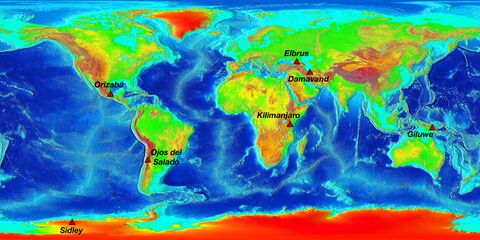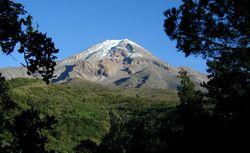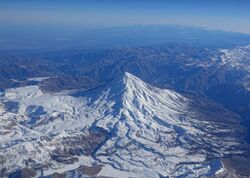Volcanic Seven Summits
Topic: Earth
 From HandWiki - Reading time: 5 min
From HandWiki - Reading time: 5 min
The Volcanic Seven Summits are the highest volcanoes on each of the seven continents, just as the Seven Summits are the highest peaks on each of the seven continents. Two of the Volcanic Seven Summits are also on the Seven Summits list. Kilimanjaro and Mount Elbrus, which were formed volcanically, are the highest peaks of their respective continents.
Definitions
Due to different interpretations of continental borders (geological, geographical, geopolitical), several definitions for the highest summits per continent and the number of continents are possible. The number of seven continents used here is based on the continent model used in Western Europe and the United States.
An additional complication in determining the highest volcanic summits is defining exactly what constitutes a volcano and how much topographic prominence it must have relative to any nearby non-volcanic peaks in order to qualify. For the purposes of this list, the summits must be an actual eruptive volcanic center, not merely made of volcanic rocks which were uplifted by other geological processes. In addition, a topographic prominence of at least 1,000 feet (300 m) is required,[citation needed] so that the list includes only genuine volcanic mountains and not minor outpourings of lava which happened to leak to the Earth's surface in high-altitude regions (see Asia below).
Africa, North America, Antarctica
No serious dispute exists as to the highest volcanoes in Africa, North America, and Antarctica—respectively, Kilimanjaro, Pico de Orizaba, and Mount Sidley.[original research?]
Australia
Although there are a few minor and inactive volcanoes on the Australian mainland, this list recognizes that the island of New Guinea is part of the Australian continent. Numerous scientific papers written in the 1970s and 1980s confirm that Mount Giluwe in Papua New Guinea is in fact an old eroded volcano,[1][2][3] unlike the higher mountains of New Guinea which are all non-volcanic in origin.
Even if this continent is defined instead as Oceania (thus adding New Zealand and Polynesia including Hawaii), Giluwe remains the highest volcano since it exceeds the elevation of Mauna Kea in Hawaii and any volcano in New Zealand.
Europe
The generally accepted geographical border between Europe and Asia runs along the crest of the Ural Mountains in central Russia and of the Caucasus along the southern border of Russia. Since the massive twin-peaked stratovolcano of Mount Elbrus rises just north of the crest, it is the highest summit in Europe and also the highest volcano.
Some geologists, though, consider the Kuma-Manych depression as the geological border between Asia and Europe. Such definition would render Elbrus entirely in Asia, making it the highest volcano of that continent (see below) and making Mount Etna (a 3350-metre active stratovolcano in Sicily, Italy) the highest volcano in Europe. Mount Teide in the Canary Islands, while active, taller than Etna and within the territory of a European country, would not be considered because geologically the Canaries belong to the African continent.
South America
Although Aconcagua, the highest peak in South America and the highest peak in the western hemisphere, does have a volcanic origin, its current high point is due to geological processes rather than being strictly volcanic.[4] Due to this, Aconcagua is not considered to be a volcano on its own, at least not as a member of Volcanic Seven Summits.
Topographic maps of the Argentina and Chile border region which contains the highest peaks suffer from poor accuracy, with elevation errors exceeding 100 metres (330 ft) in many cases.[citation needed] However, the current consensus based on the most recent measurements places Ojos del Salado as the 2nd highest peak and highest volcano in South America, significantly higher than Monte Pissis.[5]
Asia
The 5,610 m (18,406 ft) Mount Damavand is a very large isolated stratovolcano with over 4,600 m (15,000 ft) of topographic prominence.
There are more than 70 volcanic vents known as the Kunlun Volcanic Group in Tibet at higher elevations than Damavand's summit, the highest of which has a reported elevation of 5,808 m (19,055 ft) (35.5°N 80.2°E). Peaks in this volcanic group are not considered volcanic mountains but instead a type of pyroclastic cone.[6] Information about these cones is extremely scarce and the listed elevations and prominences is of unknown accuracy and reliability. It is disputed whether any of these cones have a prominence greater than 300 m (1,000 ft).[citation needed] The volcanoes in the list below all have prominences far exceeding that threshold.
Volcanic Seven Summits
| Volcanic Seven Summits (sorted by elevation) | |||||||
|---|---|---|---|---|---|---|---|
| Volcano | Elevation | Prominence | Continent | Range | Country | Coordinates | |
| Ojos del Salado[*] | 6,893 m (22,615 ft) | 3,688 m (12,100 ft) | South America | Andes | Lua error in package.lua at line 80: module 'strict' not found. | ||
| Kilimanjaro[*] | 5,895 m (19,341 ft) | 5,885 m (19,308 ft) | Africa | - | Lua error in package.lua at line 80: module 'strict' not found. | ||
| Elbrus[*] | 5,642 m (18,510 ft) | 4,741 m (15,554 ft) | Europe | Caucasus | Lua error in package.lua at line 80: module 'strict' not found. | ||
| Pico de Orizaba | 5,636 m (18,491 ft) | 4,922 m (16,148 ft) | North America | Trans-Mexican Volcanic Belt | Lua error in package.lua at line 80: module 'strict' not found. | ||
| Damavand | 5,610 m (18,406 ft) | 4,667 m (15,312 ft) | Asia | Alborz | Lua error in package.lua at line 80: module 'strict' not found. | ||
| Mount Giluwe | 4,368 m (14,331 ft) | 2,488 m (8,163 ft) | Oceania | Southern Highlands | Lua error in package.lua at line 80: module 'strict' not found. | ||
| Mount Sidley | 4,285 m (14,058 ft) | 2,517 m (8,258 ft) | Antarctica | Executive Committee Range | Lua error in package.lua at line 80: module 'strict' not found. | ||
* Note: Two of the Volcanic Seven Summits, Kilimanjaro and Elbrus, are also members of the Seven Summits. Ojos del Salado is also a member of the Seven Second Summits.
Climbing
In 2011, Mario Trimeri became the first person to summit all 12 (Kilimanjaro and Mount Elbrus are on both lists) of the Volcanic Seven Summits and the Seven Summits. Kuwaiti climber Yousef Al Refaie made a Guinness World Record [7] and became youngest climber in the world and the first Middle Eastern Arab[8] to complete the Seven Volcanic Summits at the age of 24 years 119 days when he scaled Mount Sidley (4,285 metres (14,058 ft)) in Antarctica on 22 December 2021, surpassing Indian mountaineer Satyarup Siddhanta who had previously made this record at the age of 35 years 261 days. On 9 December 2018 after scaling Ojos del Salado, Canadian climber Theodore Fairhurst became the oldest in the world to climb both the Seven Summits and Volcanic Seven Summits at 71 years and 231 days.[9] July 4th, 2023 saw Australian born Caroline Leon complete the Volcanic Seven Summits in the fastest time of 180 days.[10] [11]
See also
- Explorers Grand Slam, also known as The Adventurers Grand Slam
- Seven Summits
- Seven Second Summits
References
- ↑ Blake, D. H.; Löffler, E. (1971). "Volcanic and Glacial Landforms on Mount Giluwe, Territory of Papua and New Guinea". Geological Society of America Bulletin 82 (6): 1605–1614. doi:10.1130/0016-7606(1971)82[1605:VAGLOM2.0.CO;2]. Bibcode: 1971GSAB...82.1605B. http://www.gsajournals.org/perlserv/?request=get-abstract&doi=10.1130%2F0016-7606(1971)82%5B1605%3AVAGLOM%5D2.0.CO%3B2.
- ↑ Löffler, E.; Mackenzie, D. E.; Webb, A. W. (1980). "Potassium-argon ages from some of the Papua New Guinea highlands volcanoes, and their relevance to Pleistocene geomorphic history". Journal of the Geological Society of Australia 26 (7–8): 387–397. doi:10.1080/00167617908729105. Bibcode: 1979AuJES..26..387L.
- ↑ Mackenzie, D. E. (1985). "Giluwe and Hagen; glaciated volcanoes in the rain forests of western PNG". Volcano News 19–20: 7.
- ↑ "Geology of Aconcagua | Volcano | Plate Tectonics" (in en). https://www.scribd.com/document/24836826/Geology-of-Aconcagua.
- ↑ Biggar, John (2005). The Andes: A Guide for Climbers (3rd Ed.). Andes. ISBN 0-9536087-2-7.
- ↑ "Kunlun Volcanic Group". Smithsonian Institution. http://www.volcano.si.edu/world/volcano.cfm?vnum=1004-03-.
- ↑ ""Kuwaiti mountaineer youngest ever to climb Seven Volcanic Summits"". Guinness World Records. 6 May 2022. https://www.guinnessworldrecords.com/news/2022/5/kuwaiti-mountaineer-youngest-ever-to-climb-seven-volcanic-summits-696926.
- ↑ ""Kuwaiti mountaineer completes 7 volcanic summits challenge"". 15 January 2019. https://www.kuwaittimes.com/kuwaiti-mountaineer-completes-7-volcanic-summits-challenge/.
- ↑ "Focus, fitness paramount on Montreal's icy sidewalks: mountain climber". Montreal Gazette. 12 March 2019. http://montrealgazette.com/opinion/columnists/brownstein-focus-fitness-paramount-for-navigating-citys-sidewalks-mountain-climber-says.
- ↑ "Dubai climber aims high after scaling highest volcanic peak in Antarctica". The National News. https://www.thenationalnews.com/uae/2023/02/14/dubai-climber-aims-high-after-scaling-highest-volcanic-peak-in-antarctica.
- ↑ "Volcanic Seven Summits". James Stone. https://clachliath.com/the-volcanic-seven-summits/.
 |
 KSF
KSF







